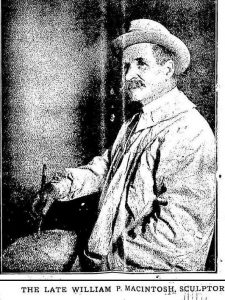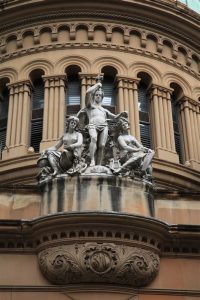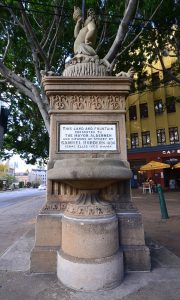
In 1897 William P. Macintosh was ‘executing every kind of sculpture’ in the yard of his Hereford St house when he received a prestigious commission. A committee comprising Sydney Mayor Isaac Ives, City Architect George McRae and Colonial Architect Walter Liberty Vernon had judged his entry the best in a competition to design twice-life-size allegorical figures to sit on top of two of the entrances to the Queen Victoria Building, then known as the New Market Buildings.
The sculptor decided that the works would be carved from Italian marble. He took his plaster models to Carrara, Tuscany, where he spent a year fashioning their transformation. En route he travelled through the USA, visiting San Francisco, Salt Lake City, Washington, Philadelphia and Boston. In Europe he spent time in Paris, Brussels, Dresden, Cologne, Berlin, Rome, Venice, London and Liverpool. Macintosh was impressed by American architecture, and considered the French school the rising power, replacing Rome as the world’s art centre.
In 1899 the marble statuary landed at Circular Quay, in two consignments. Crowds gathered in George St and York St to watch the massive pieces, covered with a coat of plaster for protection, being hoisted into place. The statues remained swathed in canvas (which grew progressively grubbier and raggedy) until their official unveiling in April 1900. (The event coincided with an outbreak of bubonic plague in The Rocks, and the Public Library’s branch inside the QVB building was closed to allow thorough cleansing of the premises and books.)

Other surviving examples of Macintosh’s large-scale figures are the Pyrmont sandstone explorers on Sydney’s Lands Department building. With James Fillans, he completed the first (Ludwig Leichhardt, Joseph Banks and Burke and Wills) in a workshop in the grounds of Sydney Technical College in Harris St. Later statues were carved in a studio on the corner of Ross St and Parramatta Rd, probably within the grounds of Braeside, the home of Colonial Architect James Barnet who had submitted the original list of explorers to Sir Henry Parkes. When a relative complained that William Hovell had been recognised but not his companion, Barnet gave assurance that Hamilton Hume’s monument was being worked on. Although placed high above street level, the Lands statues are remarkably detailed, Macintosh having consulted family members for information and photos showing their physicality down to the veins on their hands.
Macintosh also made the coat of arms above the entrance to the Commonwealth Bank in Martin Place; the flora and fauna sculptures on Sydney Technical College in Ultimo; a public drinking fountain in Pyrmont; war memorials in Double Bay and country NSW; and sculptures on public buildings in Brisbane and the AMP and Water & Sewerage Board buildings in Sydney. His last major project was the Australian coat of arms for Parliament House, Canberra. (By then he had moved to Kogarah and fashioned the stone blocks in the backyard of his house.)
Smaller commissions included a bust of Tennyson for Sir Henry Parkes, a marble and bronze medallion portrait for the Ashfield Infants Home, and mortuary statuary and death masks. ‘Smoke, joke and let dull care go by’ was inscribed on the base of a ‘Fun’ bust Macintosh made for a billiard room. It featured an ivory head, a bronze cap with electric lights instead of bells, and a gas outlet from a cigarette in its mouth where patrons could light their cigars and pipes.

Born near Ayr in Scotland, Macintosh studied anatomy and sculpture in Edinburgh before migrating to New South Wales in 1880 and enrolling in Lucien Henry’s modelling classes. In 1884 Macintosh married Margaret Eliza Page in a Congregational ceremony at Newtown. The couple lived at St Leonards where Osmond and Oliver were born and died. With their surviving son Allan, they moved to 43 Arundel Terrace Glebe in 1888 and shifted to Westmoreland St and Mount Vernon St before settling at 162 Hereford St. In 1901 Macintosh visited the Pan-American Exposition at Buffalo, New York (where US President McKinley was assassinated).
Macintosh died at Kogarah on 9 January 1930 survived by his widow, son Allan (1886-1961) and daughter Agnes Dorothy Halyard (1890-1964). At the time of his death he was studying anthropology with Professor Radcliffe Brown. He was buried with his youngest son Will Waldo (1900-26) in the Presbyterian Cemetery Woronora. Margaret Macintosh died on 7 September 1950. The Art Gallery of NSW holds ‘Youth in a Tam-o-shanta’, a portrait by Macintosh of his son Allan.
Footnote: The QVB building was threatened with demolition in 1927 to make way for the widening of York St. The Lands Department building in Bridge St has been converted to a luxury hotel.
Sources: NSW electoral rolls; NSW registry of births, deaths, marriages; Sands Directories; Trove website.

Posted on 10 July 2021 by Lyn Collingwood
For more information email: heritage@glebesociety.org.au








There are no comments yet. Please leave yours.